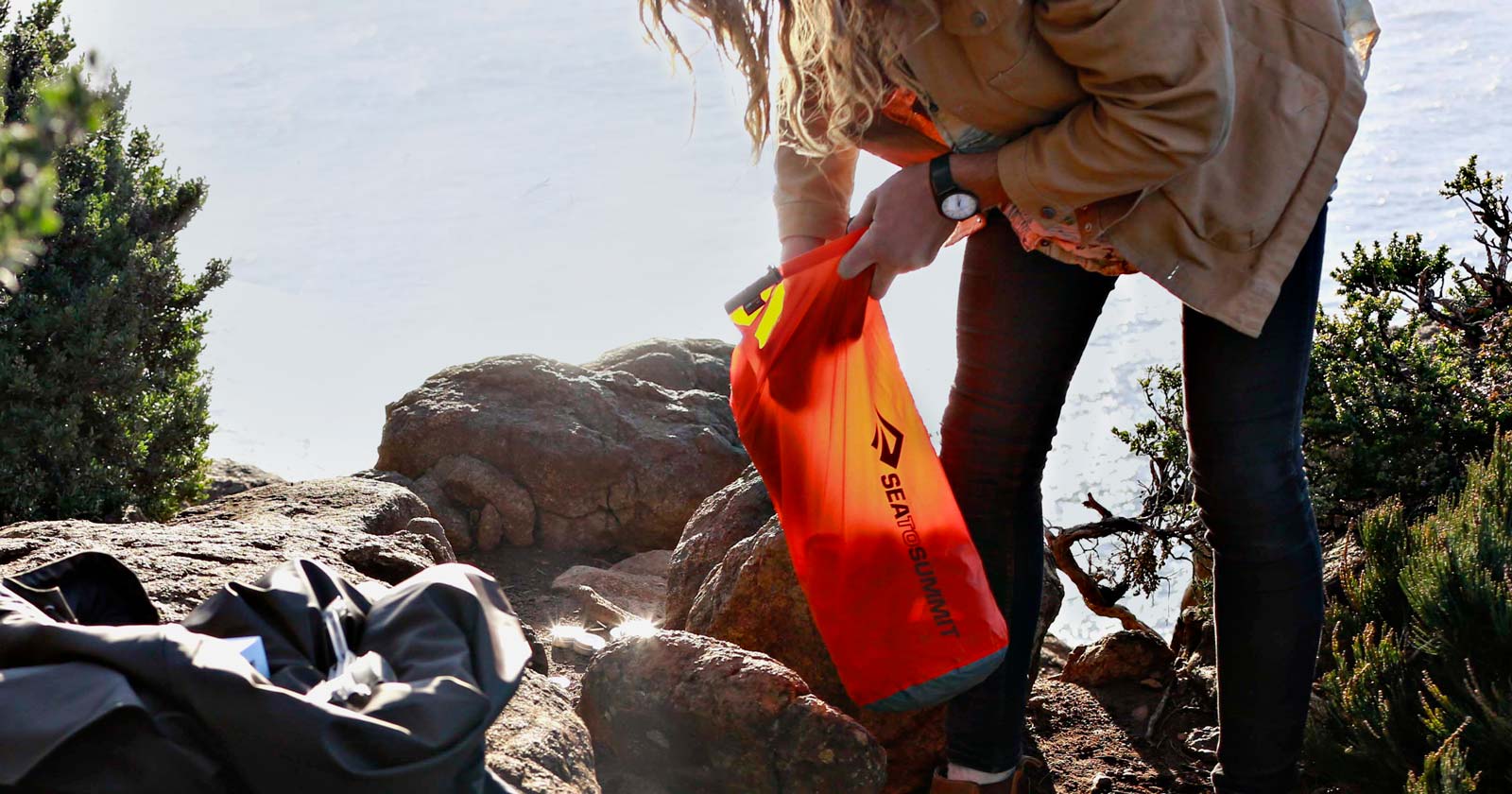Protecting your gear and keeping it dry
Stuff sacks and dry bags can make a huge difference for packing, organisation, and protection of your outdoor gear. Stuff sacks and dry bags are both storage solutions used in outdoor activities like hiking, camping, and kayaking, but they serve slightly different purposes and offer distinct features.
Stuff Sack
A stuff sack is a simple bag with an open top that can be cinched closed using a drawstring or cord lock. Its primary purpose is to help organize and compartmentalize your gear inside a backpack or duffel bag. Stuff sacks are available in various sizes and are often made from lightweight materials like nylon or polyester. While some stuff sacks may be water-resistant to a certain extent, they’re not designed to provide full waterproofing.
Dry Bag
A dry bag, on the other hand, is a highly waterproof bag designed to keep its contents completely dry, even when submerged in water. Dry bags typically have a roll-top closure system that involves folding the opening of the bag a few times and then securing it with buckles or clips. This creates a watertight seal that prevents water from entering the bag. Dry bags are commonly used in water-based activities like kayaking, rafting, and boating, where exposure to water is frequent.
Key Differences
Waterproofing: The main distinction between stuff sacks and dry bags is their level of waterproofing. Dry bags are designed to provide maximum waterproof protection, while stuff sacks offer minimal to moderate water resistance at best.
Closure Mechanism: Stuff sacks often have simple drawstring closures that are quick to open and close, while dry bags use a more secure roll-top closure system that ensures a waterproof seal.
Intended Use: Stuff sacks are primarily used for organizing and separating items within larger bags or backpacks, while dry bags are specifically used to keep gear dry in wet conditions.
Activities: Dry bags are commonly used for water-based activities where gear is exposed to splashes, rain, or submersion. Stuff sacks are more versatile and are used in a wide range of outdoor activities.
Material and Construction: Dry bags are made from durable, waterproof materials like PVC or coated fabrics, which contribute to their high level of waterproofing. Stuff sacks are typically made from lightweight, water-resistant materials that focus on organization and space-saving.
Closure Complexity: Dry bags require a more deliberate and secure closure process due to their roll-top design, whereas stuff sacks are quicker to open and close with their drawstring closure.
While both stuff sacks and dry bags offer storage solutions for outdoor gear, the choice between them depends on the level of waterproofing you require and the specific activities you’ll be engaged in. If you’re going to be around water or in rainy conditions, a dry bag is essential to keep your gear dry. On the other hand, if you’re focused on organizing items within a larger bag or want lightweight organization solutions, stuff sacks are a more suitable option.

Here’s some practical uses
Practical Uses of Stuff Sacks:
- Clothing Organisation
- Sleeping Bag and Liner Storage
- Food Organisation
- Toiletry and Hygiene Items
- Electronics and Gadgets
- First Aid Kits
- Dirty Laundry
- Rain Gear
- Document and Map Protection
Practical Uses of Dry Bags:
- Keeping essential hiking gear dry
- Water-Based Activities
- Boating and Sailing
- Beach Trips
- Camping Near Water
- Motorcycle or Bike Travel
- Traveling in Rainy Regions
- Snow Sports
- Emergency Preparedness
Tips to make the most of them
Categorise and Separate Items: Use different stuff sacks for different categories of items, such as clothing, cooking gear, electronics, and toiletries. This makes it easier to find what you need without digging through a jumbled mess.
Color Code: Choose stuff sacks in different colors or use colored markers to label them. This helps you quickly identify the contents of each sack, saving time and reducing frustration.
Compression Sacks: If you need to save space, consider using compression stuff sacks for items like sleeping bags or clothing. These sacks have compression straps that allow you to reduce the volume of the contents.
Waterproofing: For items that need to stay dry, like clothing or electronics, use waterproof stuff sacks. These will protect your gear from rain, splashes, and accidental water exposure.
Pack Organisation: Utilise stuff sacks to compartmentalise your backpack. Keep frequently needed items on top, like snacks, rain gear, and first aid kits. This minimises the need to dig through your entire pack to find essentials.
Air Expulsion: When packing items into a stuff sack, try to expel excess air before sealing it. This can help reduce bulk and make your pack more efficient in terms of space.
Avoid Overpacking: While stuff sacks can be great for organisation, don’t overstuff them. Overpacked sacks can make it difficult to close them properly and may also put unnecessary stress on the seams and zippers.
Protect Fragile Items: Use soft stuff sacks or padded cases for delicate items like camera equipment or glasses. This adds an extra layer of protection to prevent damage.
Easy Access: Place frequently needed items in easily accessible stuff sacks, like a pocket on the outside of your pack. This saves time and prevents you from having to open your main pack repeatedly.
Labeling: If you’re using similar-looking sacks, label them with a small tag or piece of tape indicating their contents. This is especially helpful for distinguishing between items like clean and dirty clothes.
Food Organisation: When camping, use stuff sacks to separate different types of food items. This can help prevent cross-contamination and make meal preparation more efficient.
Trash and Waste: Carry a lightweight, dedicated stuff sack for trash and waste. This keeps your other gear clean and makes it easy to follow Leave No Trace principles.
Easy Removal: Pack items you’ll need throughout the day, like a rain jacket, near the top of your pack and in easily accessible stuff sacks. This eliminates the need to unpack everything to reach a single item.
Maintenance: Regularly inspect your stuff sacks for signs of wear, such as frayed seams or small holes. Repair or replace them as needed to ensure your gear stays organised and protected.
Remember that the goal of using stuff sacks is to enhance organisation and protect your gear. Experiment with different arrangements and packing techniques to find what works best for your specific hiking style and gear.
Photos by Sea to Summit











